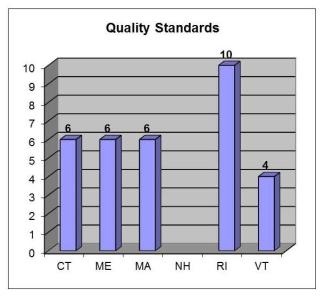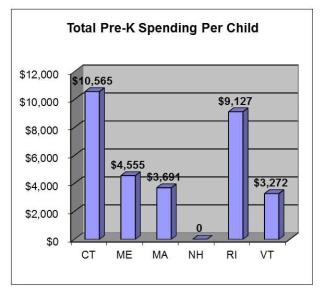
New England’s Pre-K Patchwork
May 29, 2012
A common pastime in colonial America was the quilting bee when neighbors gathered with scraps of fabric, needles and thread to create something functional. The product of these gatherings, in combination with lengthy discussion about local affairs and gossip, was a uniquely designed quilt that provided comfort to those who would huddle underneath on chilly nights.
While quilting bees may have fallen out of favor, their spirit lives on in the early educations systems of the six New England states. Yesteryear’s seamstresses today might be called “stakeholders” or “policymakers,” but all have the common task of utilizing a hodge-podge of available resources to fashion a distinct, tangible product based on an envisioned concept.
We need look no further than The State of Preschool 2011: State Preschool Yearbook to see the common and distinct features of pre-K programs across the six states. In many ways, New England is a microcosm of the nation’s pre-K system.
Five New England states currently support state-funded pre-K programs. New Hampshire is the sole outlier, joining 10 other states across the country without state-funded pre-K. Rhode Island is the most recent entrant, starting a high-quality pilot program in 2009-2010. Connecticut, Maine, Massachusetts and Vermont each support pre-K, some for three decades, with Vermont and Massachusetts operating multiple programs simultaneously.
Two states, Massachusetts and Rhode Island, have promised to undertake ambitious early education system reform initiatives bolstered by their winning coveted Race to the Top-Early Learning Challenge grants in 2011. Each New England state submitted an application with the exception of New Hampshire.
Access for children varies widely across New England. Vermont is ranked first nationally for percent of 3- and 4-year-olds enrolled, while Rhode Island’s pilot program ranks 39th in enrollment of 4-year-olds. Having no program, New Hampshire doesn’t make the chart while Maine (19th), Massachusetts (26th) and Connecticut (24th) huddle around the middle of the pack. Over the past decade, Vermont’s movement toward voluntary universal access has taken root while enrollment efforts in Connecticut and Massachusetts slid backwards.

When it comes to quality pre-K, New England looks like the rest of the nation. Only newcomer Rhode Island joins the select five states meeting all 10 research-based quality standards benchmarks. Vermont continues to meet only four quality standards while each of the other three New England state pre-K programs improved over the decade to now meet six. Only Maine and Rhode Island require all lead teachers to possess at least a BA, though nearly 100 percent of Vermont teachers have a BA or higher. For the sake of comparison, 27 states nationwide meet more than six benchmarks.

The same disparate scenario holds true for resources. As 2010-2011 figures below shows, Connecticut is second in the nation in dedicating state and total resources for pre-K, trailing only New Jersey. Rhode Island isn’t far behind. Massachusetts remains in the middle of the national pack, down sharply from 8th a decade before. Maine dramatically improves its near-bottom national standing for state support when total resources are considered. Providing only $3,272 per child, Vermont finds itself at the bottom of New England resource rankings and among the nation’s lowest funded programs. That’s still $3,272 more than New Hampshire offers, though, and is temporarily low due as the funding formula lags enrollment growth because it is based on a multi-year average.


Vermont is the only New England pre-K state to rely exclusively on state funding (though some districts choose to supplement with Title I or in-kind support), while the others combine state funding with federal and/or local resources. Half of the New England states – Connecticut, Maine, and Rhode Island – spend enough money per child to meet all 10 of NIEER’s quality standards benchmarks.
It is a shame that the best practices of each state could not be combined in a quilt that would provide every New England child with access to a very high-quality pre-K program. Depending on where a 4-year-old lives in New England, he or she could travel 100 miles and have a very different opportunity to grow and learn.
If the quilting bee participants of colonial times were to look at early education today in these states, they might be proud that their successors continue to honor the tradition of rugged individualism and making do with whatever resources can be mustered. One thing is for certain about this approach, though: many children and families are likely to be disappointed that they are still left out in the cold.
– Jim Squires, Senior Research Fellow, NIEER
The Authors
About NIEER
The National Institute for Early Education Research (NIEER) at the Graduate School of Education, Rutgers University, New Brunswick, NJ, conducts and disseminates independent research and analysis to inform early childhood education policy.

